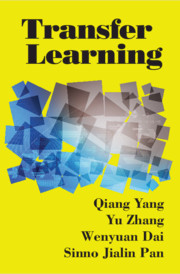
-
Select format
-
- Publisher:
- Cambridge University Press
- Publication date:
- 24 January 2020
- 13 February 2020
- ISBN:
- 9781139061773
- 9781107016903
- Dimensions:
- (228 x 152 mm)
- Weight & Pages:
- 0.73kg, 390 Pages
- Dimensions:
- Weight & Pages:
You may already have access via personal or institutional login
Book description
Transfer learning deals with how systems can quickly adapt themselves to new situations, tasks and environments. It gives machine learning systems the ability to leverage auxiliary data and models to help solve target problems when there is only a small amount of data available. This makes such systems more reliable and robust, keeping the machine learning model faced with unforeseeable changes from deviating too much from expected performance. At an enterprise level, transfer learning allows knowledge to be reused so experience gained once can be repeatedly applied to the real world. For example, a pre-trained model that takes account of user privacy can be downloaded and adapted at the edge of a computer network. This self-contained, comprehensive reference text describes the standard algorithms and demonstrates how these are used in different transfer learning paradigms. It offers a solid grounding for newcomers as well as new insights for seasoned researchers and developers.
Awards
Choice Outstanding Academic Title 2020, Choice Reviews.
Reviews
'Transfer learning is a critically important approach in settings where data is sparse or expensive. This comprehensive text focuses on when to transfer, what to transfer, and how to transfer previously learned knowledge into a novel current task. The authors cover historic methods as well as very recent methods, classifying them into a comprehensive ontology of transfer learning methods. Through its coverage of basic methods, advanced methods, and multiple application domains, the text will provide a useful guide to both novice and the experienced researchers and practitioners.'
Matthew E. Taylor - Principal Researcher at Borealis AI, Edmonton
‘This book offers a comprehensive overview of the field, arguing the case for adaptation as key to mimicking human intelligence … The book includes a substantial bibliography documenting copious citations to the literature. There appear to be few other textbooks in this field apart from this unique work. As such, it will be welcomed by libraries supporting strong computer science programs that may have need for a core text in artificial intelligence.’
D. Z. Spicer Source: Choice
Contents
Metrics
Altmetric attention score
Full text views
Full text views help Loading metrics...
Loading metrics...
* Views captured on Cambridge Core between #date#. This data will be updated every 24 hours.
Usage data cannot currently be displayed.
Accessibility standard: Unknown
Why this information is here
This section outlines the accessibility features of this content - including support for screen readers, full keyboard navigation and high-contrast display options. This may not be relevant for you.
Accessibility Information
Accessibility compliance for the PDF of this book is currently unknown and may be updated in the future.


